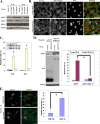mDia2 induces the actin scaffold for the contractile ring and stabilizes its position during cytokinesis in NIH 3T3 cells
- PMID: 18287523
- PMCID: PMC2366861
- DOI: 10.1091/mbc.e07-10-1086
mDia2 induces the actin scaffold for the contractile ring and stabilizes its position during cytokinesis in NIH 3T3 cells
Abstract
mDia proteins are mammalian homologues of Drosophila diaphanous and belong to the formin family proteins that catalyze actin nucleation and polymerization. Although formin family proteins of nonmammalian species such as Drosophila diaphanous are essential in cytokinesis, whether and how mDia proteins function in cytokinesis remain unknown. Here we depleted each of the three mDia isoforms in NIH 3T3 cells by RNA interference and examined this issue. Depletion of mDia2 selectively increased the number of binucleate cells, which was corrected by coexpression of RNAi-resistant full-length mDia2. mDia2 accumulates in the cleavage furrow during anaphase to telophase, and concentrates in the midbody at the end of cytokinesis. Depletion of mDia2 induced contraction at aberrant sites of dividing cells, where contractile ring components such as RhoA, myosin, anillin, and phosphorylated ERM accumulated. Treatment with blebbistatin suppressed abnormal contraction, corrected localization of the above components, and revealed that the amount of F-actin at the equatorial region during anaphase/telophase was significantly decreased with mDia2 RNAi. These results demonstrate that mDia2 is essential in mammalian cell cytokinesis and that mDia2-induced F-actin forms a scaffold for the contractile ring and maintains its position in the middle of a dividing cell.
Figures






References
-
- Alberts A. S., Bouquin N., Johnston L. H., Treisman R. Analysis of RhoA-binding proteins reveals an interaction domain conserved in heterotrimeric G protein beta subunits and the yeast response regulator protein Skn7. J. Biol. Chem. 1998;273:8616–8622. - PubMed
-
- Balasubramanian M. K., Bi E., Glotzer M. Comparative analysis of cytokinesis in budding yeast, fission yeast and animal cells. Curr. Biol. 2004;14:R806–R818. - PubMed
-
- Canman J. C., Cameron L. A., Maddox P. S., Straight A., Tirnauer J. S., Mitchison T. J., Fang G., Kapoor T. M., Salmon E. D. Determining the position of the cell division plane. Nature. 2003;424:1074–1078. - PubMed
Publication types
MeSH terms
Substances
LinkOut - more resources
Full Text Sources

